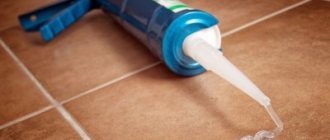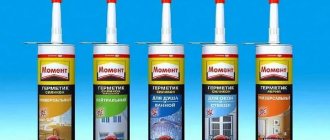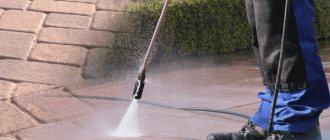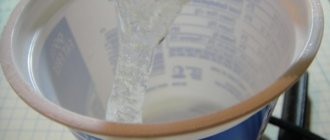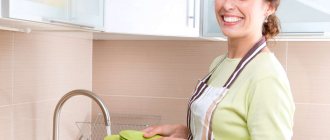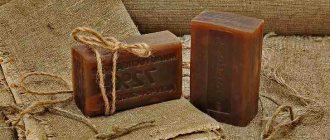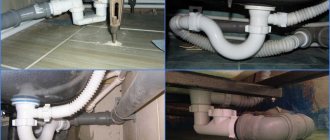Sealant is a substance made using silicone rubbers. It is widely used when performing repair work. Let's consider how to remove silicone sealant, which is especially important due to the properties of this material. Learn effective cleaning methods for various products and surfaces.
Assortment of sealants Source mr-build.ru
Types of sealant
The process of dismantling the sealing material will largely depend on its composition.
For bathrooms, substances with antiseptic additives are used that have increased moisture resistance. In rooms with high humidity, the following types of sealing agents are mainly used:
- silicone based;
- polyurethane;
- acrylic based;
- silicone-acrylic.
Silicone-containing
Silicone sealants are the most common type of material used in the bathroom. This coating has excellent moisture-repellent characteristics. Many silicone-based mixtures contain fungicides, which prevent the formation of fungus and mold on the surface. The material is characterized by excellent adhesion, resistance to temperature changes over a wide range and durability.
Silicone products have another name - sanitary sealant. The material received this name due to its good resistance to chemicals. Note that the cost of silicone compounds is quite high, which, in turn, does not make such material less popular.
Polyurethane based
This version of the sealant, after drying, forms a highly durable and at the same time elastic coating. The material is resistant to low temperatures. However, exposure to heat adversely affects the coating.
Polyurethane sealant can be used to finish vertical surfaces, as the mixture adheres well and does not drip during application. The one-component composition does not contain toxic substances, which makes it safe for human health. Paint and varnish mixtures can be applied to a polyurethane coating to improve the appearance of the material or its technical characteristics.
Acrylic
The acrylic-based composition is not inferior to silicone mixtures in many respects. The service life of the acrylic coating is also long and the level of adhesion is no lower. In addition, the material is cheaper than silicone-containing compounds.
The disadvantage of mixtures with acrylic components is their low plasticity, so this sealant can only be used in areas that will not deform over time. Otherwise, when the material dries, cracks may appear on the surface.
Acrylic mixtures contain no organic solvents, which indicates that the material is environmentally friendly and odorless. For bathrooms, only moisture-resistant modifications of acrylic sealants are used.
Silicone-acrylic
These mixtures combine all the best qualities of both types of sealant. The coating made from this material is highly durable, elastic and durable. The mixture can be used as an adhesive to hold various products together.
Features of using silicone sealant
Silicone sealant is a material characterized by plasticity and the ability to polymerize. When exposed to oxygen, it turns from a viscous paste into a strong but elastic mass. In addition, this material is able to firmly adhere to any surface. These properties allow silicone to be used to fill even small gaps.
After hardening, the composition reliably protects the holes from moisture penetration into them. Once cured, a secure bond is created that allows the material to function but prevents it from being removed. To choose the best method for removing a sealant, you need to consider its type: neutral or acidic.
Both have their advantages and disadvantages. Acidic varieties of the material include silicone and vinegar, so when they harden they emit a characteristic odor.
The advantages of this material include:
- fast curing speed;
- low cost;
- high adhesion.
At the same time, such compositions do not combine well with cement coatings, metals and natural stone. Due to the rapid hardening during work, stains of the substance should be immediately removed from the tile if they accidentally get on it. After they harden, this will be extremely difficult to do - only with the help of a solvent.
Neutral materials are made based on amines and alcohols. They are safer and more expensive. At the same time, the polymerization process of such compositions proceeds quite slowly, but after hardening it creates stronger adhesion.
It is almost impossible to wash it off after it hardens. Thus, mechanical action is often required to remove a layer of substance.
When to delete
- The sealant is not applied correctly, resulting in no protection against moisture penetration. Then the carelessly applied layer is removed, and the seam is filled with sealant again.
- Over time, the sealing layer wears out and deteriorates, and it may change color due to fading or severe contamination. The seam may crack, which will significantly impair its moisture-proof characteristics. The damaged layer must be removed immediately.
- Even if the sealant contains antiseptic additives, during prolonged use in conditions of high humidity, for example, in a bathroom, microorganisms can multiply on the surface, causing mold to quickly appear. The contaminated layer must be removed as quickly as possible, since mold that multiplies in dampness can worsen the well-being of apartment residents.
- During repairs, sealant accidentally ends up on inappropriate surfaces.
Methods for removing sealant
- Mechanical (rubbing with tools);
- chemical (solvents, removers);
- combined (combination of tools and chemicals).
Mechanical method
To work you will need the following tools:
- a sharp stationery or construction knife (you can purchase a special knife for cutting silicone seams);
- blade;
- small spatula;
- tweezers;
- flat screwdriver;
- special plastic or wooden scrapers for removing sealant;
- pumice.
Some of the tools listed may not be useful, but it is better to have them at hand: in practice, you often have to try different options to find the most effective one.
Stages of work:
- Previously, thin layers of silicone are cut off with a knife or blade. To do this, longitudinal and transverse cuts are made between the surfaces and the adjacent layer of sealant. If the silicone has not hardened too much, you can try to remove it in one motion. To do this, the longitudinal cuts are made solid and as long as possible.
- The cut edges are grabbed with tweezers or fingers and strips and pieces of old silicone are separated.
- Use a spatula or special scrapers (wooden are preferred for acrylic surfaces) to remove the residue.
Cleaning off silicone residues with a glass scraper. - If silicone gets into cracks or cracks somewhere, pry it up and pull it out with tweezers, small pliers or tongs.
- The thin layer of remaining sealant is very difficult to remove, but you can try using fine sandpaper, the hard side of a dish sponge, or a pumice stone.
- To remove sealant from tiles, you can rub it with a paper eraser or pumice stone. An eraser is especially helpful when you need to clean embossed tiles without damaging them.
- Removing bathtubs and shower trays requires at least one assistant. Dismantling begins with trimming the outer layer of silicone around the entire perimeter. Then they pry up the bathtub or tray with a screwdriver and try to loosen it. If the product gives in, it is lifted and transferred to the prepared place. Otherwise, the seal continues to be cut with a knife or blade until the bath can be disconnected.
Chemical methods
Since it is almost impossible to completely remove old sealant in the bathroom using the previous method, mechanical cleaning is often supplemented with chemical treatment.
When choosing chemical products, it is important to consider the composition of the sealant. Household silicone sealants are either acidic or neutral. Acidic ones are the most common and have a specific vinegar smell when applied. When working with neutral silicone, there is almost no odor. To effectively remove acidic silicone, the active substance of the solvent must be acid; for neutral silicone, it must be gasoline or acetone.
Available means
First of all, you can use paint thinners that you have on hand. The effect of using these liquids may be different for each individual case, so they should be tried on specific silicone and on different surfaces. At home, the following products may be useful for removing sealant:
Galosh gasoline, white spirit
White spirit (or nefras) is a universal solvent that can be used to try to soften the old seal. Moisten a rag generously with the liquid and go over the desired areas. Leave for 5 – 10 minutes for absorption. If the product has worked, the sealant softens and resembles a gelatinous mass that can be easily removed with a spatula or scraper. You can try other solvents in a similar way.
White spirit works best on cast iron or enamel bathtubs, but may not be effective on acrylic surfaces.
Vinegar + alcohol
Acetic acid and alcohol are very weak solvents and are not very effective for silicone. But there are positive reviews about the use of a mixture of equal parts of vinegar essence (70%) and alcohol (50 ml each). Sometimes the composition is supplemented with 1 tbsp. l. soda ash. The product is applied from a spray bottle and allowed to act for about 30 minutes. After softening the sealant, it is also removed with a knife. In its pure form, vinegar can be used to treat a thin layer of silicone remaining after mechanical cleaning. In some cases, this helps remove residues faster.
Kerosene, gasoline and acetone can soften neutral sealants, but they have practically no effect on acidic ones.
Industrial silicone cleaners
Industrial products disrupt the structure of the sealant and cause its gradual destruction. Silicone solvents can be purchased at construction stores or auto care stores.
The principle of removing sealant with different professional compounds is the same:
- After preliminary mechanical cleaning, the product is applied with a sponge or simply with your finger (always wearing gloves).
- After a certain time (must be indicated on the packaging), the remaining product along with old silicone can be easily removed with a brush, plastic spatula or scraper. Often the necessary tools are included with the cleaner.
- Many industrial silicone solvents leave a greasy residue on the surface, often yellow in color. They are treated with a soap solution, kept for a while and washed. Laundry soap works well when lathering a sponge and treating oily areas. The foam is washed off, and the surface is wiped dry and finally degreased with acetone or white spirit, and then dried with a hairdryer.
Chemical products for removing silicone are available in the form of sprays, removers, gels or pastes. The following products received positive reviews and recommendations:
- Tytan (Selena, Poland). The active ingredient is phosphoric acid. Does not have a pungent odor. Dissolves even dried silicone. The operating time of the cleaner is 12 hours. The product is effective on textured surfaces, so it can be used to clean tiles with a three-dimensional pattern. Leaves greasy marks. Tytan composition for removing silicone.
- Universal car cleaner XADO Mottec Antisilicone (Ukraine) alcohol-based. Designed for degreasing and cleaning the surface from silicone and traces of adhesive tape. Suitable for acrylic and ceramics. Does not require rinsing and leaves no residue after drying. XADO Mottec universal cleaner.
- Silicone cleaner gel Soudal (Belgium) hydrocarbon based. It is easy to apply and has a moderately pungent odor. The minimum duration of action is 10 minutes. Apply only to dry surfaces. On acrylic, stone, ceramics and plastic, preliminary testing is advisable. Leaves greasy stains. Soudal hydrocarbon silicone remover.
- Car aerosol wash Body Antisil 770 (Greece) based on organic solvents is a universal product for cleaning any surfaces. Safely removes silicone and bitumen residues, but re-treatment may be necessary. Body Antisil degreaser.
- Dow Corning (Dow Sil, USA) is a fundamentally new silicone-based solvent cleaner. Activates the process of silicone depolymerization. Safe for the environment and any surfaces, does not change the color of painted products and does not leave marks. Available in aerosols (Dow Sil OS-2 series) and liquids for dissolving old sealants (Dow Sil DS-2025 series). Environmentally friendly aerosol solvent Dow Sil OS-2.
- Solvent remover Penta-840. Removes traces of silicone from tiles, metal and acrylic surfaces. Apply with a generously moistened sponge. The surface to be treated is covered with film and left for several minutes. Remains of sealant can be easily removed with a sponge or improvised means. The product is dangerous if inhaled, in contact with skin or eyes. May cause corrosion of metals with prolonged exposure. Penta-840
Best deals on silicone cleaners:
Note: Work with any solvents or industrial products only with gloves and in a well-ventilated area.
Chemicals
If mechanical methods are completely unsuitable, then chemical agents with special compositions come to the rescue.
It is believed that they can quickly get rid of unsightly residues of sealant or at least prepare them for cutting. Chemical means for removing silicone sealant should not be understood as powders, household cleaners, or any chemicals with abrasives.
Their use on an acrylic bathtub is fraught with serious consequences in the form of a damaged coating with various scratches and erased places.
The choice of solvent also greatly depends on the composition of the sealant that was used in the repair. There are acidic and neutral mixtures. In the first case, the base is acetic acid, which evaporates when it hardens. The second option is made on the basis of components such as amides, alcohol, ketoxime and amines.
If the former are removed using acetic acid, gasoline, white spirit, kerosene and ethanol (the most effective remedy), then for others you will need products based on concentrated alkalis.
The solvent may leave greasy stains, but don't be alarmed. They can be easily removed with ordinary household chemicals, such as dishwashing liquid or laundry gels.
During the work, you may need napkins or rags, wooden spatulas.
The following products can deal with sealant:
- Lugato Silicon-Entferner is a specially developed cleaner for silicone residues. Its consistency is a paste, which is evenly applied to problem areas and left for several hours. It must be removed not just with a rag, but with a wooden spatula. The product will be removed with the tool along with the remnants of the hated sealant. It is well suited for both acrylic and many other surfaces, so it can be used by the master in further work;
- Soudal Silicone Remover is a product for softening and removing silicones that are in a solid state. It is intended to prepare the surface for applying a new layer if sealant has already been used there, but it is also quite applicable in the case of excess. The product is distinguished by the fact that it has a pleasant lemon scent and a brush with a spatula included so that the application of the gel is as precise and accurate as possible;
- Penta 480 is already a liquid, which, according to manufacturers, copes with both fresh and old sealant. Also, using this product you can easily refresh or replace seams. It is used as follows: soak an ordinary rag and apply it to the required areas, after which the whole thing is covered with polyethylene to create a greenhouse effect;
- Dow Corning OS-2 is a product available in three variations: liquid, spray and paste. It is quite popular among craftsmen because it is easy to apply and quickly removes the sealant. Apply to the sealant, leave for 20 minutes until it softens and simply remove. The main thing is to equip yourself with protective gloves and even a mask when using an aerosol. The product is considered very aggressive, so first you should test it on a small and almost invisible area to avoid unpleasant consequences;
- White spirit is another high-quality product that has a low cost compared to analogues. The work will consist of two stages: first, part of the sealant is cut off, and then the spirit is rubbed in with a soft cloth. This should help soften the sealant, which can then be easily removed with a regular spatula. Thus, the original appearance of the bathtub is restored and the acrylic coating does not deteriorate;
- You can also add products such as HG Silicon seal remover, Mellerud, Soudal, Sili-kill. When choosing, proceed from your personal needs and the quality of the sealant used, if such information is available.
Important ! One should not forget about precautions, even if the manufacturer assures that the acrylic coating product is completely safe.
Before applying it to all problem areas, it is better to check the effect of the liquid or paste in advance. To do this, it is applied to an inconspicuous place, and after some time the reaction of the enamel is checked.
Naturally, even after checking there is no need to relax too much. All products with a complex chemical composition must be applied exclusively to places where the sealant needs to be removed. Otherwise, the bathtub and tiled covering may simply be damaged and cannot be restored by any means.
Also, you need to be careful when using chemicals. They can cause allergic reactions both on the skin and in the eyes and even have a negative effect on the olfactory organs.
Experts advise not to despair at the first failures and to use different solvents alternately to achieve significant results.
How not to spoil the surface
To avoid having to repair plumbing or change the finish later, all work on removing sealant is done as carefully as possible and without haste. Acrylic products require special attention: with strong friction they can be scratched even with the hard side of a dish sponge, and rough brushes are generally contraindicated for such surfaces. Therefore, when removing sealant, you should remember the following safety precautions:
- You must work with the blade and knife very carefully to avoid injury and not to scratch the walls, glass, floor or plumbing.
- A thin layer of sealant from acrylic coatings can be safely rubbed off with an eraser, damp pumice, aged sandpaper, a wood chip or a block of untreated but soft wood (such as pine).
- Sometimes the silicone is so hardened and ingrained into the surface that it cannot be removed mechanically: it cannot be cut even with the sharpest blade. In such a situation, it is necessary to first soften the sealant using folk remedies or professional compounds.
- You should not risk trying to tear off the silicone by force: it may come off along with the top layer of the bathtub or a piece of tile.
- When choosing a silicone remover for an acrylic bathtub, you need to pay special attention to the active substance of the solvent: caustic compounds can damage the surface. Ideally, the packaging should contain information about the possibility of using the product on acrylic materials. Acrylic surfaces cannot be treated with acetone.
How to clean without damaging the surface
To avoid damaging the tile surface when removing hardened sealant, you should cover the area above the treated area with masking tape. When carrying out mechanical cleaning, it is necessary to avoid applying too much pressure on the tile with a sharp knife. You can wipe off the remaining substances in hard-to-reach places and on the surface using a knife or blade.
The procedure must be carried out as carefully as possible: this will help avoid scratches.
If silicone does not respond, it is best to treat the contaminated area with a chemical solvent and wait a while. This will slightly increase the cleaning time, but will also help protect the surface from damage.
How to remove acrylic sealant
Acrylic sealants can be water-soluble or water-resistant. But their main function is not sealing, but gluing. Compositions for interior work are porous and, as a rule, water-soluble. Therefore, in the bathroom their use is limited to places where water does not get in (you can glue various hooks, mirrors or shelves).
Waterproof acrylic sealants are designed for exterior finishing and construction work. In general, they are universal and after complete drying they are not afraid of moisture, but constant contact with water has a bad effect on their properties. Waterproof acrylic glue is sometimes used to install borders (or baseboards) for bathtubs and washbasins, which is not entirely correct.
Removing acrylic sealant is much easier than silicone:
- excess fresh glue can be easily wiped off with a sponge or rag moistened with water;
- the old dried composition is cut out with a stationery knife or blade;
- water-soluble acrylic is moistened with water until softened;
- Waterproof acrylic sealant can be removed from the edges of an acrylic bathtub with mounting foam, acetone, nail polish remover or a solvent such as white spirit;
- the remaining composition is removed with a wooden scraper or plastic window cleaner;
- Acrylic sealants do not leave greasy marks or stains after removal, so additional treatment with solvents is not required.
Procedure
Industrial preparations affect the structure of the seal, causing its gradual destruction. Ready-made solutions are sold in construction stores and automotive supply outlets.
There is a single principle for using professional products:
- mechanical cleaning of the area is carried out;
- the drug is applied with a sponge (you need to wear thick rubber gloves);
- At the end of the exposure time, the remaining sealant is removed with a plastic scraper, brush or spatula - the tools are often included with the cleaner.
Industrial formulations often leave behind greasy, yellow-tinged residues. For removal, a soap solution is used - a small amount is applied to the contaminated area, left for 3-5 minutes and washed.
Laundry soap has a similar effect; it is lathered on a sponge and processed. The foam is later washed off, the area is wiped dry, then degreased with acetone or white spirit, and dried with a hairdryer.
What and how to wipe off the sealant
Immediately after application, the substance is difficult to see on the surface, but after a few hours it turns from transparent to white. It becomes clear which surfaces will require removal of splashes, stains or alignment of seams and joints.
Dried or hardened silicone composition can be removed mechanically by scraping with available tools.
The method is used when solvents or detergents cannot be used.
Tools
- Construction spatula. The wide handle makes it easy to use for removing even heavily dried sealant. The edge of the tool must be intact, and if there is a jagged edge, it is useless and even dangerous to use, as there is a possibility of damaging the surface.
- Construction scraper. Helps quickly remove adhesive residues without destroying tiles.
- Razor blade. For the most inaccessible places, small stains are quickly erased. Due to its small size, the blade is not always convenient to use; if handled carelessly, you can cut your hands.
- Shoe knife. Helps remove very thin layers of adhesive.
- Screwdriver. The sealant is removed in hard-to-reach areas. In order not to damage the tiles, you need to work without strong pressure.
- Forceps, tweezers, pliers. Tools can be used to grab loose parts of the sealant if this cannot be done with your fingers.
Special tool. They are a handle with interchangeable attachments of different shapes. Nozzles are selected for any angle and type of surface. It can remove both old waterproofing and seal the seams with a new mixture.
Cleaning procedure
- First, remove the top layer of silicone with a knife or blade. To do this, a longitudinal and transverse cut is made between the treated base and the adjacent seam layer. Slightly hardened waterproofing is cut off with one maximum longitudinal movement.
- If it was not possible to completely remove the silicone in one go, you need to grab the cut edge with your fingers and separate all the pieces one by one.
- Residues are removed with a spatula or scraping tool.
For acrylic surfaces, it is better to use wooden spatulas.
- Old waterproofing is removed from cracks and cracks using plucking tools.
- It is difficult to cut off a thin waterproofing layer; it is usually rubbed off with sandpaper, pumice stone or steel wool for cleaning dishes.
- To clean the embossed surface without damaging it, use a school eraser or pumice stone.
- When dismantling an acrylic bathtub or shower tray, first cut the outer seam around the entire perimeter of the bowl. Then it is pryed off with a screwdriver and slightly loosened. If it does not pry off immediately, continue to cut off the influx with a knife until the bowl is detached from the base.
Ways to clean sealant from bathroom tiles
You can quickly remove any type of sealant only before it hardens. Some effort will be required once it has cured and adhered to the surface. Most of the composition can be removed mechanically. To prevent mechanical damage to the tiles, you should additionally use a chemical cleaning method.
Mechanical method
Most of the hardened silicone can be removed with a sharp knife designed for jointing.
In addition, during the work you will need the following tools:
- putty knife;
- eraser;
- blade;
- flat screwdriver;
- scraper;
- pumice.
First you need to take a knife and trim the sealant near the wall and the side of the bathtub. After this, using tweezers, you can remove the separated layer of the substance. This does not allow you to completely remove the sealing material, but you need to use other tools to remove any remaining silicone stuck to the surface.
In places where the sealant has filled the cracks, pry it up with tweezers and pull it out. In this case, the procedure should be carried out slowly so that the captured area does not accidentally rupture.
Mechanical removal of sealant requires care and precision.
Chemical method
Sealants soften when in contact with solvents, but it takes quite a long time to wash off the silicone. Chemical cleaning methods are used as additional ones: large volumes are difficult to eliminate. They are used after the main part of the substance has been eliminated mechanically.
Acid sealant is treated with compounds containing acid. To remove neutral silicone, you can use white spirit, gasoline, kerosene and acetone. To remove old substances from bathroom fixtures, it is recommended to use special flushing agents.
After removing the bulk of the silicone, the remaining part can be washed off with solvents.
How to remove mechanically?
Carefully removing a thick layer of silicone and cleaning large areas covered with sealant is possible, provided that sharp objects are used.
Using a sharp stationery or construction knife or razor blade, cut off the layers of sealant. To do this, you need to very carefully trim the layer of silicone adjacent to the surface of the tile.
If the material is not very hardened, after cutting it can be removed with one jerk. Pieces of hardened sealant are cleaned from the surface of the tile using a narrow metal spatula, scraper and tweezers.
In hardware stores you can purchase special sets of knives for removing silicone sealant. The sets consist of a handle and attachments of various shapes with a sharp blade.
The very thin layer of silicone remaining on the surface is cleaned off with the hard side of a dishwashing sponge or an eraser.
It is not recommended to use hard sandpaper, much less a metal brush. Such tools leave very deep scratches that disfigure the surface of the tile.
Mechanical removal
The first thing that comes to mind is using a sharp cutting object to clean the surface of excess substance. Excess can be detected a few hours after hardening. The composition takes on a white tint and you can see where improvements are needed.
Important! The use of mechanical cleaning means requires special care to avoid damaging the tile surface.
To scrape off frozen silicone, use a knife, scraper, blade, spatula or other sharp object.
If the composition has already become embedded in the tile, then it is not recommended to completely remove the excess. There is a high probability of damage to the seam, which will cause depressurization of the joint.
How to scrub with improvised means?
Minor traces of sealant will help you clean the available products without much effort:
White Spirit
A universal solvent that softens layers of silicone sealant on tiles.
Traces of sealant are thoroughly rubbed with a cloth soaked in solvent. After five to ten minutes, the silicone softens to a jelly mass, after which it is very easy to remove it with a scraper or plastic spatula.
Acetic acid and alcohol
A cleaner that gently removes traces of the sealed silicone layer from tiles.
For cleaning, you need to prepare a composition of acetic acid and alcohol (mix in equal proportions). The resulting product is sprayed through a spray bottle onto the silicone mark, left for half an hour, and then carefully scraped off with a knife.
To clean hardened particles of sealant, a mixture of alcohol and acetic acid is supplemented with soda ash (1 tbsp is enough).
Dichlorvos
Simply spray the product onto the sealant and leave for ten minutes. Thanks to the solvent in the cockroach spray, the silicone softens very quickly and can be easily removed with a rag or sponge.
The use of Dichlorvos in enclosed spaces is prohibited (the drug is toxic). When cleaning tiles, the bathroom doors should be open and the forced exhaust fan turned on.
Treatment of joints in the bathroom with silicone
Before applying the polymer, the surfaces are cleaned of dust and grease. Otherwise, the connection will not be of high quality. To do this, they are wiped with white spirit. Then a hair dryer is used to dry the coating and improve the interaction of the structures.
Before applying the putty, apply masking tape at a small distance from the future seam. It will protect the surfaces from the spreading of the substance and its peeling in the future. The tape is glued as evenly as possible so that the future joint is beautiful.
Conventional sealant is packaged in a tube with a plastic tip. Its tip is cut so that the cut diameter matches the width of the seam. Then the tube is placed in a special gun and the substance is injected along the entire length of the joint being processed.
How to clean with special compounds?
On the shelves of hardware stores there is a wide range of aerosols, pastes and solvents, using which you can quickly and accurately remove traces of sealant from bathroom tiles. The TOP 3 most popular and effective means are presented below:
Penta 840
Remover for silicone and polymer materials Penta 840 easily dissolves hardened sealant on tiles.
It is enough to cover the traces of silicone with a rag, generously moistened with Penta 840 remover. After just five to ten minutes, the hardened sealant will soften to such an extent that it can be easily removed with a rag or sponge.
The average cost is 470 rubles. (volume 900 ml).
Dow Corning R-40
Dow Corning R-40 Surface Cleaner is an alcohol solution containing surfactants that will quickly clean the silicone layer from the tiles and degrease the surfaces.
Suitable for cleaning:
- ceramic,
- metal,
- glass,
- painted surfaces.
The average cost is 1520 rubles. (volume 1 l).
Sili-Kill
Sili-Kill Silicone Cleaner will easily remove sealant from tile, enamel, glass and even porcelain. Does not contain flammable, toxic solvents.
Method of application: cut off the sealant as much as possible with a sharp knife, moisten the remaining residue on the tile surface with Sili-Kill cleaner, after twenty minutes remove the sealant with a wooden stick or a soft spatula.
The average cost is 400 rubles. (volume 100 ml).
Before using any special product, you must carefully read the manufacturer's instructions. Do not exceed the contact time of chemical compounds with the surface of the tile or use several chemicals at the same time.
Another preparation for cleaning tiles from sealant and its use is in the video:
Chemical removal
Damage to the surface of ceramic tiles can be minimized using chemical compounds. These substances do not involve mechanical action.
Solvents are most often used. There are special formulations for sealants on the market. If there is a large stain, the excess is cleaned using mechanical tools, and then chemicals are applied.
Scrapers, spatulas and knives - means for mechanical removal of excess
Replacing sealant
After cleaning the seams, you can begin replacing the sealant. First, you need to apply masking tape to the tiles to avoid getting the product on areas that do not require treatment.
If you plan to seal the joints between the sides of the bathtub and the walls covered with tiles, it is better to use compositions that include a biocide. This substance will prevent the formation of fungus.
First, the surface should be degreased and dried. You need to prepare a tube of sealant according to the instructions. The product is carefully applied to the surface, and then a seam is formed. You need to remove excess sealant with a putty knife or an old plastic card. After 12 hours, you should also remove the masking tape.
To replace the sealant, place masking tape on the tile and carefully process the seam.
Cleaning tiles
During the renovation process, tiled bathroom walls are often stained with silicone. The grout comes to the surface after processing the seams and polymerizes in a short time. Then they use special substances to scrub it off.
You need to remove silicone from tiles in the following order:
- Use a knife or blade to cut off large pieces of putty. For the glazed surface, use a scraper made of wood or plastic so as not to spoil it.
- The remaining polymer is softened with any suitable solvent. Soak a rag in the selected substance and apply it to the stained area for a short time.
- Remove the softened mass with unnecessary material.
- Fatty traces on the treated surface are washed off with a soap solution.
Cleaning Precautions
When removing old silicone, be sure to wear gloves and safety glasses. Most solvents are flammable, so you should absolutely not carry out processing near open flames or heating devices.
After using chemicals, be sure to wash your hands thoroughly. When working with sharp tools, it is important to be careful to avoid cuts.
Be sure to wear gloves when working with solvents.
Advice from professionals
Experts recommend:
- Before using a chemical, you need to apply it to a small and inconspicuous area of the bath and monitor the reaction of the material to the chemical. This way you can avoid damage to the product.
- When working with sealant, it is advisable to wipe off drips and drips before it hardens.
- Silicone substances have a destructive effect on products made of polyacrylate and polycarbonate. In this regard, it is not prohibited to combine them.
- You should always follow the rules for working with chemicals.
With a competent approach to the procedure, removing the sealant from the bathtub will not be difficult.
Tips and tricks from professionals
When using chemicals to remove silicone caulk, test on an inconspicuous area of tiles and fixtures. This will allow you to check the reaction of the surface to the substance used. It is advisable to cover with masking tape areas where chemical compounds are undesirable.
You should not try to pull out the frozen mass with a sharp movement. This can lead to damage to the tile joints. When planning to apply a new layer of silicone, you need to thoroughly dry the surface. Even if the material sticks to a wet surface, fungus will subsequently form underneath it.
Sources
- https://stroy-podskazka.ru/germetiki/kak-ubrat-v-vannoj/
- https://KraskaGuru.ru/germetiki/stroitelnye/sposoby-udaleniya.html
- https://MasteraVannoy.ru/problemy/kak-ubrat-silikonovyj-germetik.html
- https://yborka.online/uborka/kak-ochistit-vannu/germetik/s-plitki-vv
- https://yaplitka.ru/sposoby-udaleniya-germetika-s-plitki-v-vannoy-komnate.html
Precautionary measures
Substances designed to remove layers from the surface are toxic, for this reason compliance with safety regulations is required. The master must wear rubber gloves, a respirator, and closed clothing. The room is provided with high-quality ventilation.
To prevent substances from getting onto the tiled surface, it is recommended to stick masking tape along the border. If you choose the composition in a can, then it is sprayed with extreme care; it is too easy to get into an unnecessary area, so most of the nearest surface is covered. After removing the material, the chemical composition is washed so that it does not remain on the tiles.
To prevent substances from getting onto the tiled surface, it is recommended to stick masking tape along the border.
